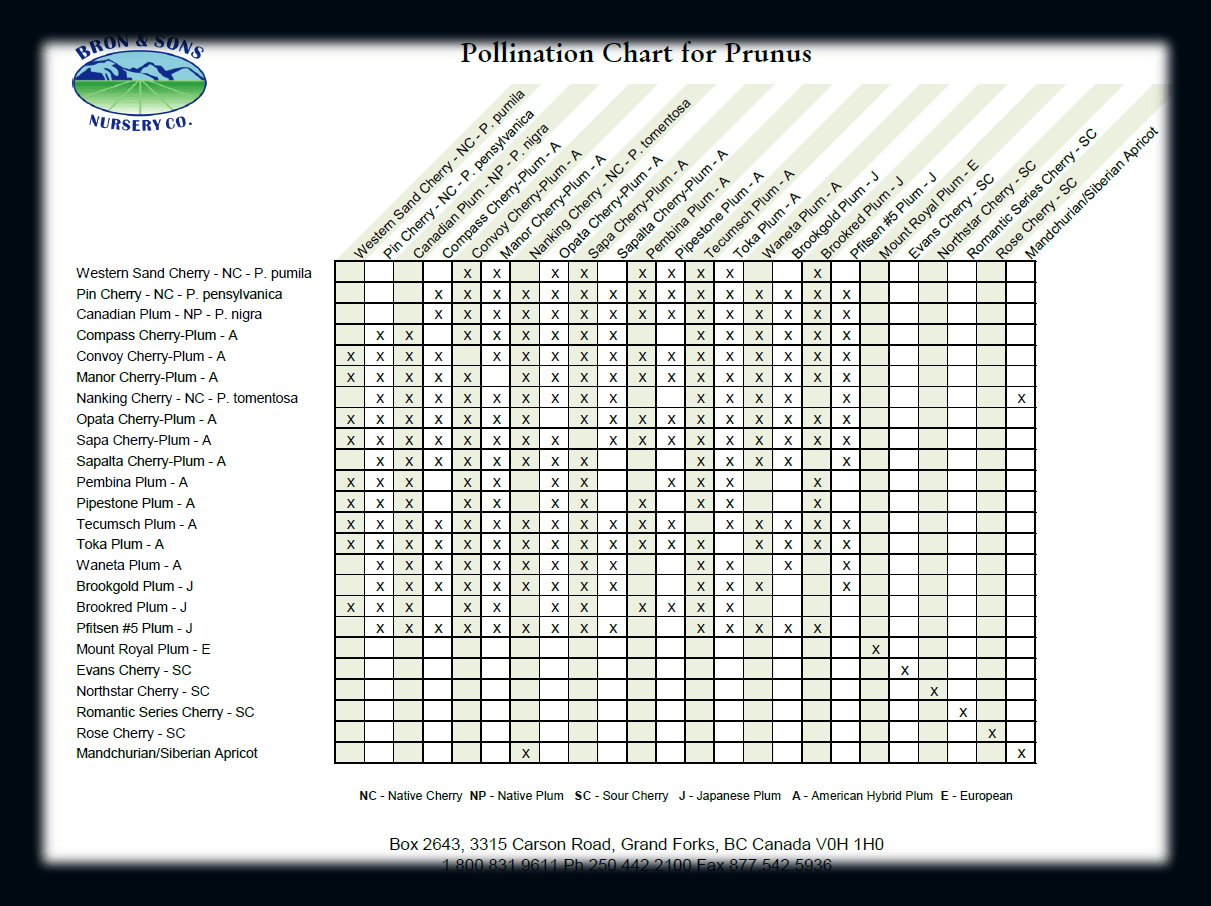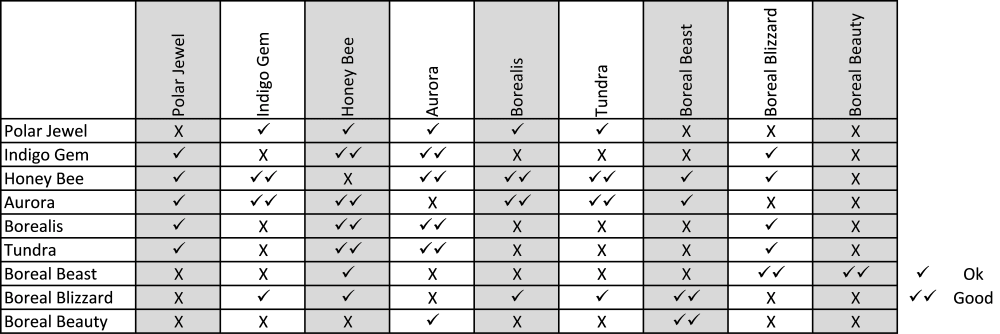
Detailed Prunus Pollination Chart
General Pollination Tips for Cherries & Plums (Prunus)
Sour cherries are self-pollinating; only one tree is needed for fruit production. Evans, Montmorency, Northstar and the Romantic series fall into this category.
Plums and cherry-plums are divided into five different groups; American Hybrids (A), Damson (D), European (E), Japanese (J) and Native (N).
In order for cross-pollination to occur, it is essential that the varieties bloom at the same time. Varieties that bloom mid-season will cross-pollinate both early and late-blooming varieties, as well as other mid-season bloomers.
- Early bloomers include Brookgold Plum (J), Nanking Cherry (N), Sapalta Cherry-Plum (A), Compass Cherry-Plum (A), Pfitsen #5 (J) and Waneta Plum varieties (A).
- Mid-season bloomers include Convoy Cherry-Plum (A), Norther Plum (N), Sapa Cherry-Plum (A), Toka Plum (A), Manor Cherry-Plum (A), Opata Cherry-Plum (A), Tecumsch Plum (A) and Western Sand Cherry (N) varieties.
- Late bloomers include Brookred Plum (J), Pipestone Plum (A) and Pembina Plum (A) varieties.
Many chokecherries will also aid in cross-pollination. The closer the relationship between species, the larger and more abundant the fruit will be.
General Pollination Tips for Apricots (Prunus)
European apricots are self-pollinating. Only one tree is needed for fruit production. Manchurian and Siberian apricots fruit more dependably when other apricot varieties or Nanking cherries are nearby.
General Pollination Tips for Apples & Pears (Malus and Pyrus)
In order to have fruit from apple and pear trees, you often need a second tree for cross-pollination. As long as the second tree is within 500 feet (150m), pollination should occur. Within city limits, most apple and pear trees will be pollinated by insects carrying pollen from the neighbours’ trees.
If your apple or pear trees are not performing well, the following trouble shooting list may help you to determine why:
Cool, rainy weather conditions during flowering.
Unfortunately in this case, other than hoping for better luck next year, there is nothing to be done. Bees and pollinating insects do not fly during cold , wet and windy weather.
Old, unproductive trees that do not flower.
Generally, apple and pear trees have a productive life span of about 30 to 40 years. Trees older than this should be replaced. Trees can be rejuvenated by removing old, unproductive growth and allowing new growth to replace it.
A poor crop the year following a bumper crop.
Some apple varieties have a tendency to perform biennially, with a large crop one year, not much the next, and a large crop again the third year.
No tree of the same genus (i.e. Malus) nearby.
It is best to pollinate fruit trees of the same genus with each other – apples with apples, as long as both trees bloom at the same time. Pears & Apples can cross-pollinate but are not dependable.
The other cultivar in yard is sterile.
Some but not all ornamental crabapple trees work for cross-pollination purposes. A few varieties have sterile pollen.
Lack of pollinating insects, such as bees.
Try adding to your flowerbeds. Most flowering plants are almost guaranteed to attract bees. The annual herb "Borage" and the perennial "Beebalm" (Monarda) are especially good for this purpose. Because their flowering times coincide with those of many fruit trees, marigolds, pansies, spurge, trollius, and arabis are the best choices.
The trees are of the same variety.
Clones will not pollinate each other; for example, a Norland apple tree cannot pollinate another Norland apple tree.
Grapes (Vitis)
Grapes are self-pollinating. Regular pruning is essential for fruit production. To do this, remove all suckers from the base of stems after the end of June. Remove ends of canes two to three leaves past the last fruit cluster. Remove all non-producing canes.
Blueberries (Vaccinium)
Blueberries are self-pollinating, but two or more varieties that bloom at the same time will result in better yields and larger berries.
Currants and Gooseberries (Ribes)
Currants and gooseberries are self-pollinating. Excellent fruit production can be obtained with just one plant. If currants are grown near gooseberries or josta berries however, yields can be even better!
Black currants perform better when different cultivars are grown together. Note that black currants will not cross with red or white currants; the reverse is also true.
Josta berries (Ribes)
Josta berries are a cross between gooseberries and black currants. Two or more bushes are required to ensure fruit production. Josta berries will cross-pollinate with gooseberries or currants.
Strawberries, Raspberries, Goji Berries and Saskatoons (Fragaria, Rubus, Lycium and Amelanchier)
Strawberries, raspberries, goji berries and saskatoons are all self-pollinating.
Kiwi Fruit (Actinidia)
Both male and female plants are required to produce fruit. You need at least one of each plant, but a male can cross-pollinate up to 8 females. Plants must be 2 to 3 years old before they will produce fruit.
Haskap (Lonicera)
Like apples, Haskaps require 2 genetically different varieties to produce both the largest and highest quantity of fruit – both will produce. For ‘Borealis’, ‘Tundra’ & ‘Indigo Gem’ use ‘Polar Jewel’/ ‘Berry Blue’™ or ‘Honeybee’.
